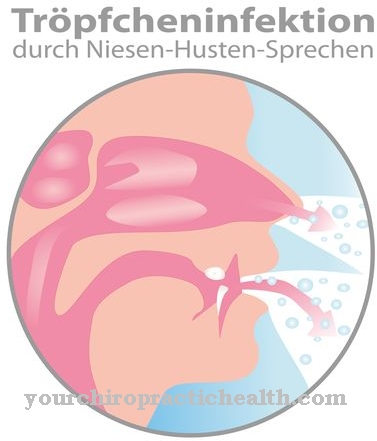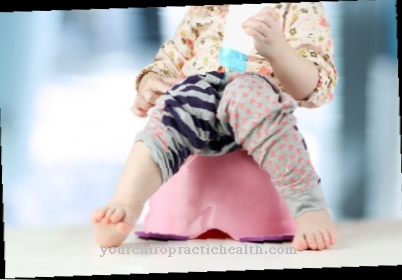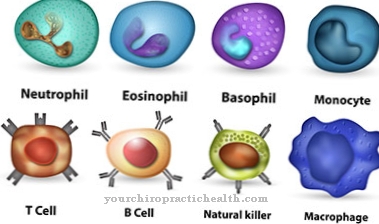At the Short rib polydactyly syndrome it is a collective term for a large number of diverse osteochondrodysplasias that are present in sick people at birth. Short rib polydactyly syndrome is a congenital disease with a genetic background. Short rib polydactyly syndrome is characterized by shortening of the ribs and hypoplasia of the lungs. As a result of these complaints, the short-rib polydactyly syndrome usually ends early and fatal for the affected person.
What is short rib polydactyly syndrome?

© 4th Life Photography - stock.adobe.com
The Short rib polydactyly syndrome is congenital, although the exact frequency of occurrence of the disease has not yet been researched. The inheritance pattern present in short rib polydactyly syndrome is autosomal recessive. In principle, it is possible to diagnose short rib polydactyly syndrome prenatally, whereby the typical defects in the skeleton and in some cases also the underdeveloped lungs can be recognized.
In most cases, however, short-rib polydactyly syndrome does not appear until newborn infants are born. The short rib polydactyly syndrome usually leads to the death of the affected patients, whereby the persons do not reach the average age. In principle, the underdevelopment of the lungs is decisive for the death of people suffering from short-rib polydactyly syndrome. In addition, shortened ribs appear as part of the syndrome.
In addition to the shortening of the ribs, in short-rib polydactyly syndrome the thorax is usually also hypoplastic. Due to the underdeveloped lungs, the organ is not sufficiently able to supply the body with blood and oxygen. As a result, the patients suffer from respiratory insufficiency. In addition, short-rib polydactyly syndrome is usually shortened and deformed in the long bones.
In addition, people suffering from short-rib polydactyly syndrome often have polydactyly. In addition, short-rib polydactyly syndrome is often associated with anomalies of the heart, a cleft lip and palate, and malformations of the intestines and urinary tract. The esophagus, the windpipe and the epiglottis are sometimes affected by malformations. The thorax is not only narrowed, but also often shaped preaxially.
However, short-rib polydactyly syndrome is an umbrella term for numerous different symptoms that are very similar to one another. For example, Ellis-van-Creveld syndrome and Jeune syndrome belong to the short-rib polydactyly syndrome. These two diseases are usually not fatal. In contrast, Majewski syndrome, Saldino-Noonan chondrodysplasia, Beemer-Langer syndrome and Verma-Naumoff syndrome are usually fatal. Yang syndrome and Le Marec syndrome also exist.
causes
The short rib polydactyly syndrome arises as a result of genetic mutations, whereby an autosomal recessive inheritance is present. It is not known exactly whether short rib polydactyly syndrome predominates in female or male patients. Basically, the short-rib polydactyly syndrome is innate, so that there is no possibility of influencing the pathogenesis.
Symptoms, ailments & signs
The term short-rib polydactyly syndrome stands for numerous congenital disease syndromes that are assigned to the genetically determined osteochondrodysplasias. The short rib polydactyly syndrome is often characterized by a lethal outcome. Underdevelopment of the lungs combined with shortening of the ribs is typical of most syndromes.
Depending on the syndrome present, there are also other symptoms. The rib cage is usually underdeveloped in short-rib polydactyly syndrome. The patients suffer from pronounced respiratory insufficiency due to the hypoplastic lungs, which is a common cause of death. In some cases, people with short rib polydactyly syndrome have a flat nose, a lateral cleft in the lip, and bulges on the skull. Sometimes the back of the patient's head is noticeably flat.
Diagnosis & course of disease
A diagnosis of short-rib polydactyly syndrome is made by a specialist who specializes in hereditary diseases. In addition, a diagnosis in a medical institute for inherited skeletal defects is possible. A diagnosis usually takes place in newborn or child patients, so that the parents are present with the anamnesis and the subsequent clinical examinations.
They also support the doctor with family history, as short-rib polydactyly syndrome can occur more frequently within families. In the clinical evaluation of short rib polydactyly syndrome, the doctor uses imaging techniques to examine the abnormalities in the skeleton. He also analyzes the development of the lungs.
By means of a lung function test, the specialist recognizes the performance of the organ and may be able to make a prognosis. When diagnosing short rib polydactyly syndrome, it is important to identify the exact syndrome. The doctor examines the patient for signs of Majewski's syndrome and Saldino-Noonan syndrome, for example.
Complications
The short rib polydactyly syndrome can lead to a wide variety of complaints. For this reason, it is usually not possible to make a general prediction about the further course and complications of this disease. These depend strongly on the respective syndromes and can lead to various restrictions in life. However, those affected by short rib polydactyly syndrome are usually associated with complaints of the lungs.
It is not uncommon for this to result in shortness of breath or shortness of breath. The internal organs in particular can be severely damaged by an insufficient supply of oxygen, resulting in irreversible consequential damage. The short-rib polydactyly syndrome also leads to permanent fatigue and exhaustion in the patient. Those affected also suffer from reduced resilience.
It is not uncommon for the short rib polydactyly syndrome to develop malformations of the ribs, resulting in a crooked posture for the patient, which can have a very negative effect on the quality of life. It is usually not possible to treat short-rib polydactyly syndrome causally. Treatment, therefore, is based on the symptoms and aims to limit them. Usually there are no complications. In most cases, however, a complete cure is not possible.
When should you go to the doctor?
After an inpatient delivery, various examinations and tests are carried out by obstetricians and paediatricians in a routine procedure to determine the health of the newborn. During this procedure, the signs of short rib polydactyly syndrome are usually noticed by the trained staff. Many infants have cleft lip and palate in addition to skeletal irregularities, so immediate medical treatment is instituted. In addition, the child's breathing is impaired and is analyzed.
The relatives do not have to take action independently in these cases due to the presence of the specialist staff.In the case of a home birth, the midwife or the outpatient obstetrician team take care of the initial anamnesis. In the event of discrepancies, you will also independently initiate the necessary measures and contact a doctor. This is followed by rapid in-patient admission so that the child can receive adequate medical care. If a sudden birth occurs without the presence of a medical nurse, a doctor's visit is necessary immediately after the birth.
An ambulance service should be alerted if there are visual abnormalities in the skeletal system, problems with breathing or other irregularities. Before it arrives, first aid measures must be taken so that the newborn does not suffocate. In particular, the ribs and the back of the head show worrying changes and cannot be overlooked. The ribs are shortened and the back of the head is flat.
Treatment & Therapy
The treatment of short rib polydactyly syndrome focuses exclusively on the symptoms, since a causal cure of the disease is not yet practicable. The focus is on the individual complaints of the patient with short-rib polydactyly syndrome. In some people, skeletal defects can be partially corrected through surgery.
Therapy of the underdeveloped lungs is more difficult. Often there is no permanently effective treatment option, so that numerous patients die as a result of short-rib polydactyly syndrome. However, this does not apply to forms of the disease without a basically fatal course. In the case of non-lethal manifestations of short-rib polydactyly syndrome, adequate therapy makes a significant contribution to the quality of life of the patient.
You can find your medication here
➔ Medicines for painOutlook & forecast
The term "short rib polydactyly syndrome" encompasses a whole range of hereditary skeletal diseases. These manifest themselves after birth or before birth. Some diseases in this syndrome are fatal, but others are not. The prognosis for the various diseases that are summarized here is therefore differently good or bad.
The shortening of the ribs and the hypoplasia of the lungs are responsible for a fatal course of the short rib polydactyly syndrome at a young age. The defects on the skeleton - sometimes also the stunted lungs - can nowadays already be detected in the context of pregnancy diagnostics. The problem, however, is that the lung damage usually only becomes apparent after the birth.
Lung damage is also the reason why those affected die after a few weeks or months. The prognosis for the affected infants is so poor mainly because the underdeveloped lungs in short-rib polydactyly syndrome are not able to supply the organism with sufficient oxygen. In addition to the two eponymous injuries of short-rib polydactyly syndrome, infants can also have other injuries to the body.
The diseases that are summarized as short-rib polydactyly syndrome often cause irreversible consequential damage at an early stage. The diagnosis of short rib polydactyly syndrome must carefully distinguish which form of the disease is present. The survival prognosis for the clinical pictures of short rib polydactyly syndrome is only better with Ellis-van-Creveld-Syndrome and Jeune-Syndrome.
prevention
So far, doctors have not yet succeeded in effectively preventing short-rib polydactyly syndrome. The causes of the development of the disease lie in mutations of genes, so that currently no preventive measures can be carried out. However, research is working to prevent congenital defects such as short-rib polydactyly syndrome. At present, only a prenatal diagnosis of short rib polydactyly syndrome is possible, whereby the doctor recognizes the underdevelopment of the lungs and the shortening of the ribs.
Aftercare
With short-rib polydactyly syndrome, the affected person usually has only a few or even no special follow-up measures available. In the case of this disease, a doctor should be consulted at an early stage so that no further complications and complaints can occur. An early diagnosis usually has a very positive effect on the further course of the syndrome and can also prevent the symptoms from worsening.
In this form of the disease, there is usually no independent healing. In most cases, the symptoms of short rib polydactyly syndrome are treated by various surgical procedures. After these interventions, the person affected should keep a strict bed rest and protect his body. You should refrain from exertion, physical and stressful activities in order not to continue to unnecessarily burden the body.
In many cases, measures of physiotherapy and physiotherapy can also be used to increase the patient's mobility again. Many of the exercises can also be performed in your own home to further alleviate the symptoms. As a rule, short rib polydactyly syndrome usually does not reduce the life expectancy of the person affected.
You can do that yourself
Depending on the form and extent of the short rib polydactyly syndrome, different symptoms and complaints occur. The medical therapy and self-help measures must be individually tailored to alleviate these symptoms and to go through the treatment without complications.
Underdeveloped lungs can be compensated to a limited extent by exercise and physiotherapy. In order not to overload the organ, all sporting measures should only be carried out in consultation with a specialist. The malformation of the ribs can promote a hump and is mainly a visual flaw. Children and young people in particular need the support of an adult here. Parents should speak to teachers immediately if they are excluded. Attending a self-help group can be an important help for the sick person, as talking to other sufferers helps to understand and accept the condition.
After an operation using the VEPTR procedure, the patient must initially remain in the hospital for a few days. Sufficient distraction should be created so that postoperative depression does not occur. Regular visits from friends and relatives are an important psychological support and thus contribute indirectly to recovery.


.jpg)






















.jpg)

.jpg)
